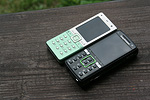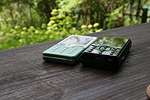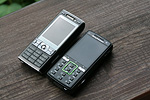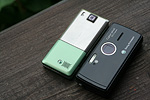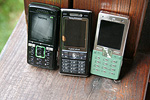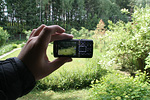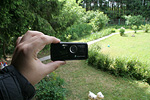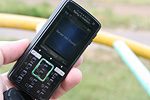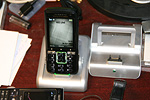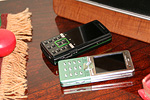|
|
Review of GSM/UMTS-handset Sony Ericsson K850i
Life photos of Sony Ericsson K850i
Content
- Positioning
- Design and controls
- Display
- Keypad
- Memory, memory card
- Built-in motion sensor
- Battery
- Performance
- Connectivity
- Hardware platform A2, software platform A200
Sales package:
- Handset
- Charger
- Battery
- Wired stereo-headset (non Walkman-branded)
- USB data cable
- M2 memory card (availability and size vary by region)
- User Guide
Positioning
The Sony Ericsson K850i is the company’s flagship device and is here to stay for at least a year – it will be only the second quarter of 2008, when the market will start seeing more solutions coming in 5 Mpix camers onboard. Basing on how popular the previous models were, it is safe to say that over at Sony Ericsson they are trying to seize this wave and embrace all solutions that previously were so sought-after in on the market. Will they make it? It is not so obvious, though due to the growth of the company’s business in the first place. While originally Sony Ericsson swayed towards the techi audience and also the fashion-conscious consumers, today they are going for the broader audience. The Sony Ericsson K850i is a living essence of these ideas – they have forgone the camera shutter, and the new experience bears strong resemblance to ordinary digital cameras. We pondered over these alterations and what they bring to consumers in our review on the K850i’s camera.

But this camera issue aside, the handset’s ergonomics has changed in a dramatic way, with the touch-sensitive keys jumping on its front fascia and thus requiring the conventional device management scheme to go different ways, and the navigation key thrown into the rows of numeric buttons – together all these things have an impact on this solution’s ergonomics. It is aimed exactly at techi, the audience ready to get such innovations and come to grips with them. But on the other hand, the ultimate goal was a mass-market device for unsophisticated users, so that’s the point where we come to a controversy.
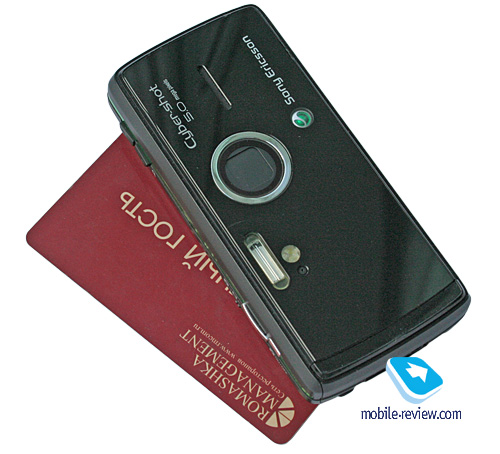
Will this handset be as popular as the company’s former flagships? Definitely yes, it will sell really well in spite of all crucial modifications in the approach. But will it enable a step forward, a quantum leap for the company? As it is, as one single model? Because if you remember the previous solutions, the Sony Ericsson T610i was a breakthrough that gave birth to a whole new field then it was the Sony Ericsson K750i, and finally the Sony Ericsson K800i. Does the Sony Ericsson K850i qualify as breakthrough of today?
From my point of view, it does not – undoubtedly, it is interesting for its technological talents, but brings nothing totally new. Let’s recall technical innovations of the previous devices:
- Sony Ericsson T610i – first mass-market model with bundled camera;
- Sony Ericsson K750i – first model with photographic quality of shots, do-it-all solution – player, radio, games;
- Sony Ericsson K800i – Java multitasking capabilities, enhanced interface, new platform – A1/A100, on release had top-notch camera;
Is the Sony Ericsson K850i the first mass-market device sporting a 5 Mpix camera? By no means, the market already has the Nokia N95, which is even popular than “all the rage”. To me it looks like an obvious misstep of the marketers over at Sony Ericsson – they could not believe that Nokia’s expensive solution would conquer the market. According to our estimates, every second owner of the Nokia N95 could have been a potential buyer of the Sony Ericsson K850i, had the handsets hit the market within a one- or two-month interval from one another.
The foundation of this misstep was the previous experience, as in the rivalry between the Nokia N93 and the Sony Ericsson K800i, the former was a clear outsider, and people were not really willing to buy it. The crux was not in the smartphone versus feature phone dispute, as they assume sometimes. It was about ergonomics, queer design of the Nokia N93 and more importantly its size. But in the case of The Nokia N95 and the Sony Ericsson K850i, there is no such point, these devices are pretty much in line dimensions-wise.

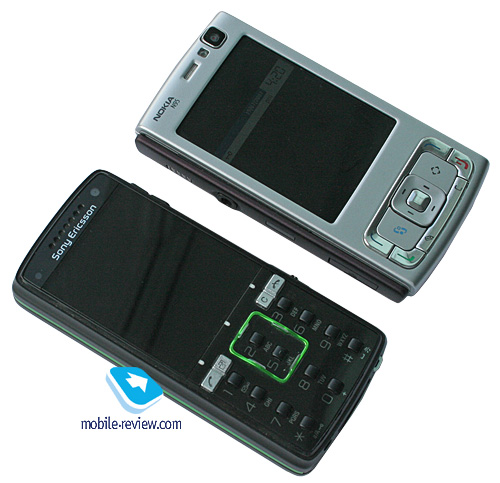
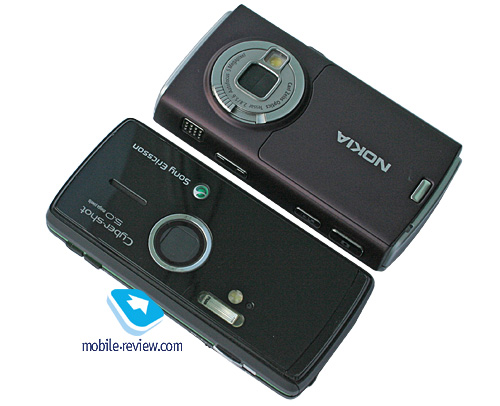

Originally the Sofia, which is the codename of the Sony Ericsson K850i, was slotted for early summer. Then, polishing of A2/A200 platform got postponed; what is more, the major rival in the form of Nokia rescheduled the release of S40 5th edition. In fact, over at Sony Ericsson they messed the strategy up – whereas previously they had recognized both feature phones and smartphones as the competition, at that point in time they decided on feature phones alone. And the S60 got knocked out of this group, deemed a pricey and differently positioned platform. This is a mistake that can cost the company a lot in the future. For the time being the entire range of Sony Ericsson is rivaled both by the S40 and S60 products.
Functionality-wise the Nokia N95 is far more powerful than the Sony Ericsson K850i, and on top of that it has been around for a long while. For carrier-based markets, where purchase of a handset is accompanied by contracts, leading to a very favorable price tag for consumers, it is not a big deal which one to go for. Price tags step into the background and don’t make all the difference – what really starts to matter is style, and the slider type form-factor, which is more demanded these days.
And we come to see a truly controversial picture – Sony Ericsson launches a candybar aimed at traditions-driven, somewhat conservative audience. Then in this very product, it changes the concept of device management and forgoes everything it had before, this includes shifting to the Nokia’s interface (more on that later). Any sort of previous user experience to come in handy here? No. The Sony Ericsson K850i marks a break in this aspect. And getting itself a place under the sun won’t be an easy walk, like that the previous models had. Most consumers have no clue about implementation of specific functions before purchase and pick their handsets by other parameters. So the main audience for this device is the users loyal to Sony Ericsson, while the mass market needs a fraction more.
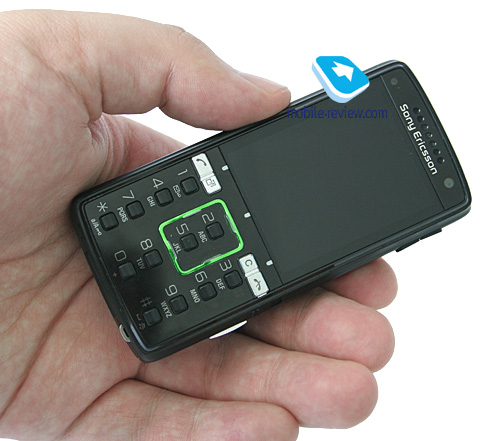
For the very first time, the future of a flagship from Sony Ericsson doesn’t look particularly promising, as the phone lands into a very competitive environment outright. Probably, this will force an upgrade of this model to come sooner. We’ll hope for this, but certainly with the fact that the Sony Ericsson K850i will claim the flagship position for a year to come in mind.
I repeat that what I have just listed are only the first bells ringing that have much to do with the company’s growth and maybe they will get over these problems in 2007-2008. If they won’t, Sony Ericsson is liable to start losing the aura of the technological leader, which is utterly dangerous for the company.
Back to the table of contents >>>
Design and controls
The handset’s design doesn’t follow up the company’s trademark style, having no rounded edge and thus looking more rectangular and somewhat sharp – this lends it a tubby feel. Both on pictures and in real life the handset has always seemed chunky to me, and at a glance I’ve always considered it to be bigger than the Sony Ericsson K800i. To my great surprise, this has been a mere optical illusion, because if you put it face to face with the K800i, you will definitely notice that the K850i’s casing is slimmer.

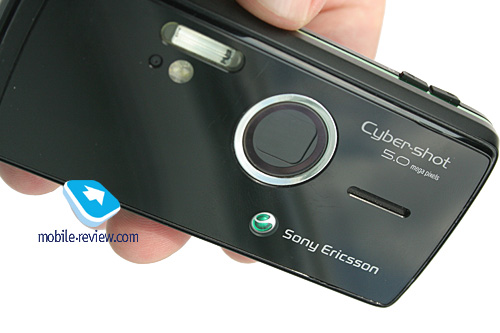
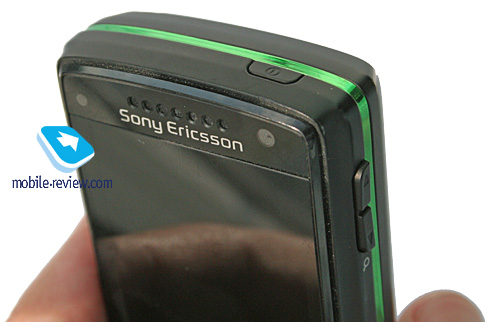
Dimensions – 102x48x17 mm, weight 118 grams. For comparison, the Sony Ericsson K800i measures up at 106x47x18 mm, weight 115 grams.

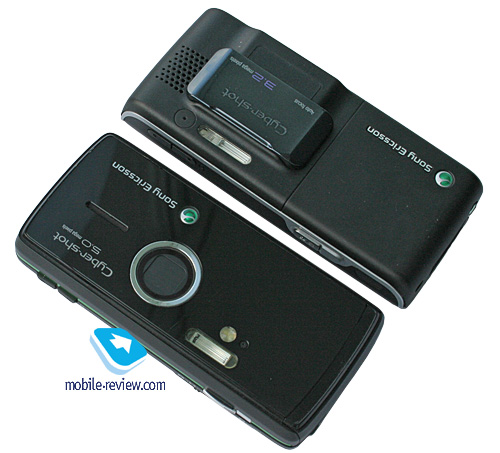
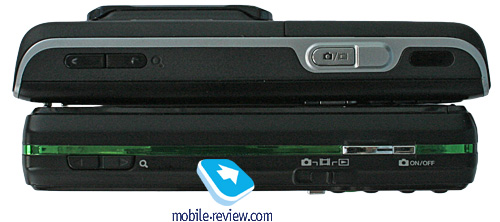
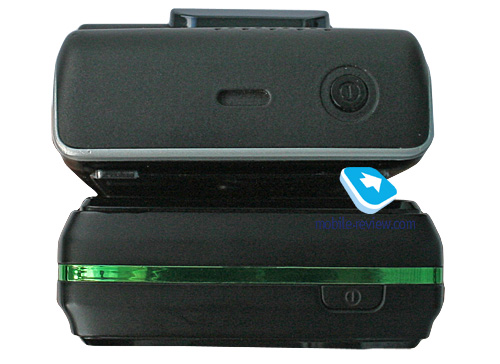
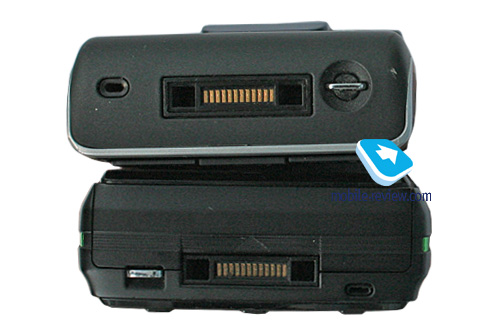
Not only do they try to dub the model as the maker’s flagship, but also highlight its design, specifically with the help of this motto - «State of the art performance». The K850i comes in a choice of two colors - Luminous Green and Velvet Blue, and in both cases the plastic the front face is coated in is black, while the navigation key’s rim and the side-mounted inset vary in color. Only the blue-painted edition features silver spines, and in its turn the rear is, so to say, clad in transparent plastic, which is uncommon for phones, although the same bottom layer is employed in some Sony’s digital cameras. The plastic quality is nothing that we would complain about; it especially looks good on the black casing edition, though the blue one also has some charm to it. But regardless of color scheme, the front fascia, finished in glossy plastic, easily picks up fingerprints and smudge.
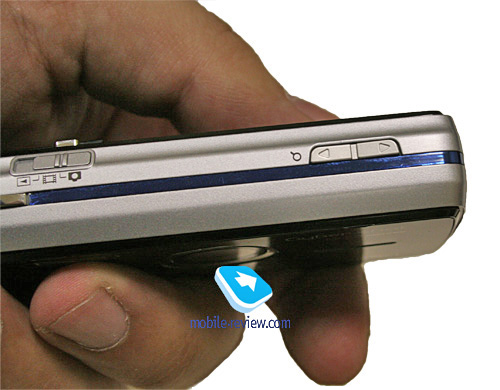
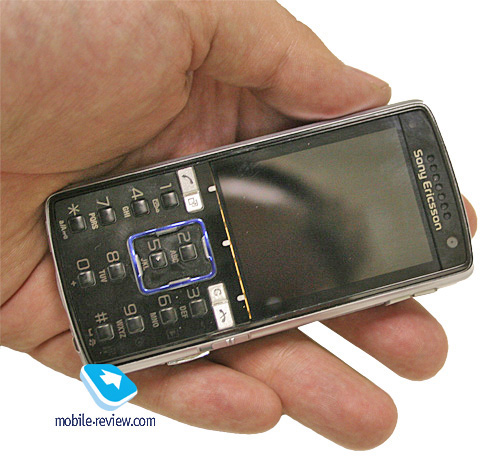
The easiness the K850i picks up dirt and grease with is something we should highlight in a separate paragraph – the handset has way too many glossy surfaces on it, in fact, the side plates are the only exceptions here. So a few hours into your quality time with the phone, it gets smudged all around; some might find this really irritating. The underside is clad in glaring plastic. But technically they have decided to go for a “sandwich” design – the plastic surface has a thin metal bottom layer, which protects the handset’s inners and lends the casing that robust feel. If you press on the rear, it bends a bit, so it is kind of flexible. It would be all good, if hard pushes didn’t make it creak, which hasn’t been spotted on the previous models. Also, over a month of our quality time, we got a crack on the inside of the rear plate – the plastic couldn’t stand the pressure in a pocket (I don’t think it was much, our unit never landed on hard surfaces). Even though it is visible only at certain angles and it hasn’t been growing larger ever since, we don’t feel very enthusiastic about its presence.
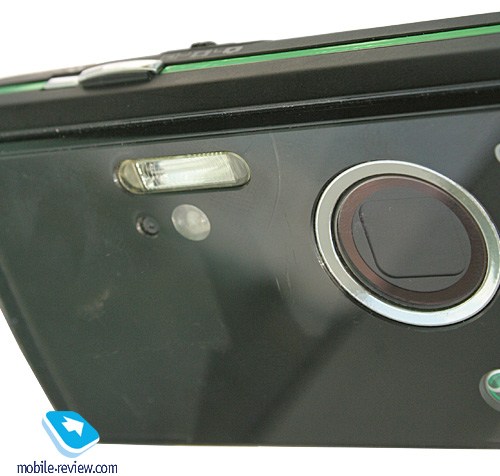
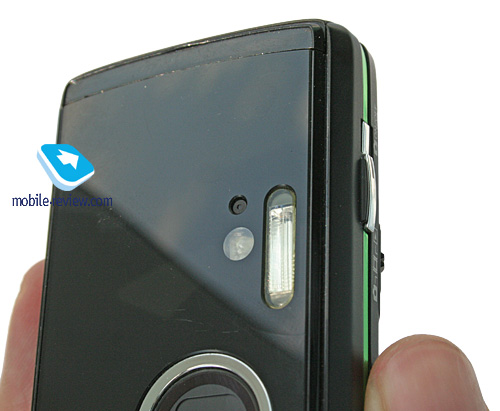
The back cover cannot be removed, instead look at the bottom end, where the standard Fast Port sits along with the battery hatch, which is quite novel, and under this cover are the SIM-card bed, microSD/M2 memory expansion slot, and also the battery compartment, where it gets locked with a latch.
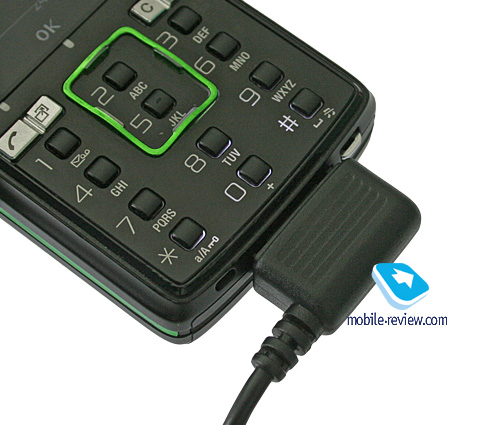
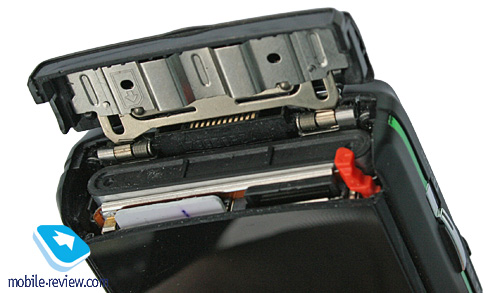
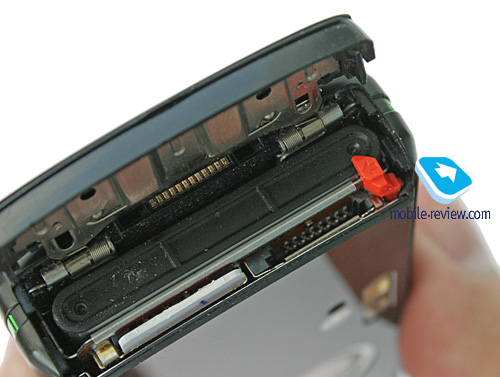
Back to the table of contents >>>
Display
The handset’s display slightly outdoes that found in the Sony Ericsson K790i/K800i, measuring 2,2 inches from corner to corner (previously – 2 inches). The QVGA (240x320 pixels) allows it to accommodate up to 8 text and 3 service lines, but with smaller fonts you can squeeze more lines into it. Like before, this screen displays up to 262K colors (TFT) and has a mirror layer, which does help it get along with direct sunlight and increases viewing angles. Similarly to the Sony Ericsson T650i, this handset enjoys mineral glass protecting the display.
If we are to compare it with the Sony Ericsson K800i, the picture has gotten sharper, chiefly thanks to the bigger diagonal, but still it hasn’t become this much better. The display is just fine, standing up to other today’s models, yet there is nothing extraordinary to it.
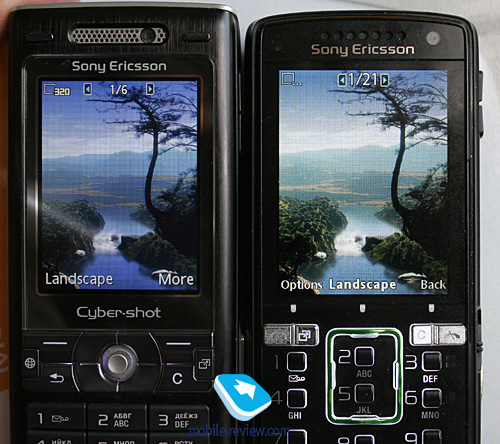

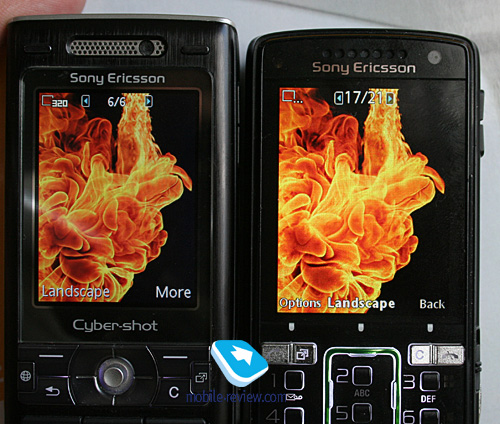
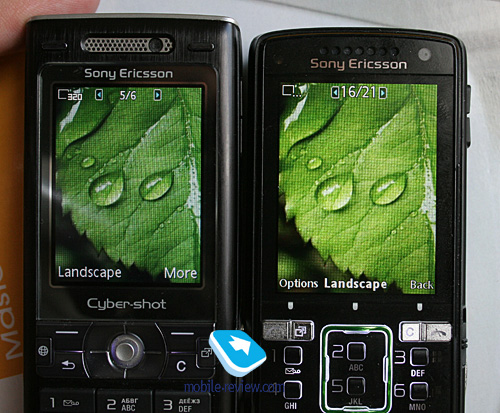
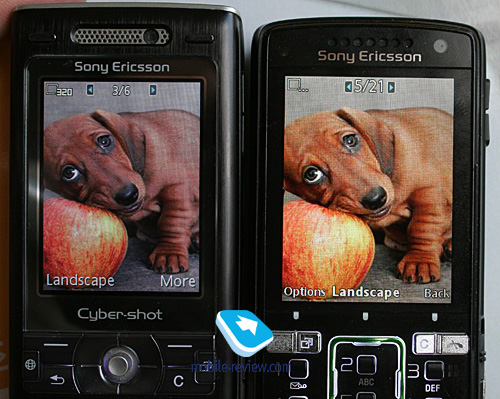
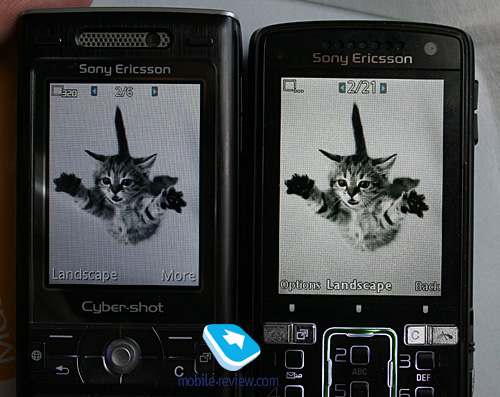
Back to the table of contents >>>
Keypad
The keypad is designed in a not particularly common way – its keys are shaped as small squares similar to those the Sony Ericsson T650i has. Even though it might look clunky and fiddly, it proves to be quite easy to use. The first thing you must learn is punch the buttons with your finger pads, then it will be a breeze to use. Basically, the motive of “mastering it from the ground up” goes through this phone. The navigation key is also pretty quaint, as it is placed alongside numeric buttons, but thanks to its protruding edges, it is a breeze to handle.
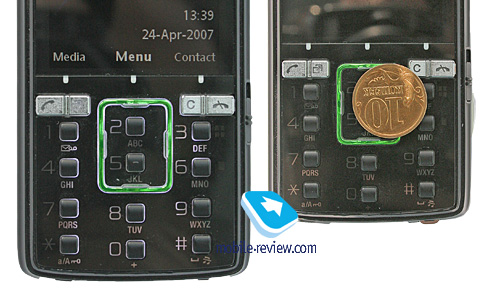
The keypad is lit in white, which is well-visible in various environments. The keypad also enjoys some light effects, when backlighting color for every row is keyed to some rhythm, which is fetching and adds a stylish touch to the phone. This solution made its first appearance in the Sony Ericsson T650i.
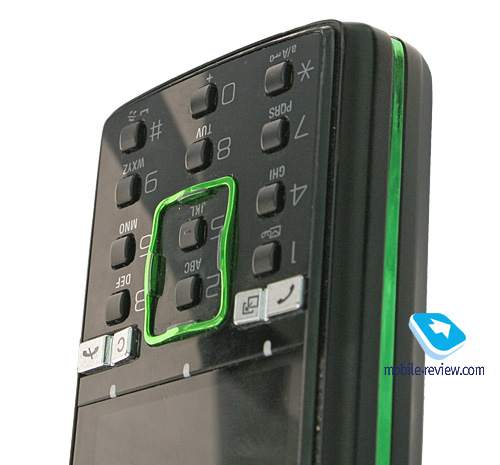
The display has three touch-sensitive zones beneath it (like the Motorola RAZR2 V8), where you will find context-sensitive buttons. With this solution, they have shaved off one row of buttons, so that now OK and two soft-keys are touch-sensitive, you will face no problems with managing them, and moreover, like in all previous models, the actions they perform depend on the menu you are in. An interesting approach that will leave a lot of leftover space on handsets in future and make for bigger numeric keys.
While in the RAZR2 V8 these zones are represented by touch-sensitive areas put on the display’s surface itself, the K850i employs a different technology. The bottom edge of the screen features three white dots, which are in fact the touch-sensitive areas – when pushing them your finger occupies most of the surface and touches these sensors anyway, that’s the way it works. We experimented with cold and warm items and came to a conclusion that temperature has nothing to do with the way the handset reacts to presses. The bottom edge of the screen is a tad loose, as the protective glass of the display goes up and down a bit. The durability question is still to be answered – even though the company put the K850i to the test, it is still not clear what real-life use might reveal.
At first the touch-sensitive pads don’t feel conventional, but then you get used to them, and everything gets back to normal. Ergonomics-wise they are slightly inferior to conventional keys, but only slightly, that’s it. Overall, the K850i sports an average keypad that needs some getting used to.
Back to the table of contents >>>
Memory, memory card
The handset comes with about 40 Mb of inbuilt memory, which can be used to store both personal data and applications. Behind the hatch sits the double-purpose slot for MS M2 or MicroSD memory cards. It is the first time when the company offers a choice between M2 cards, utilized by various Sony-branded gadgets or the previous handsets, or slightly cheaper microSD units. The price tags of these two memory card types are almost identical, so are their abilities. So it all boils down to personal preferences and having certain memory cards at hand. Sony Ericsson makes a good statement with this move, as other makers force owners of their handsets to use only one specific card type.
In terms of physical design, this is a two-way socket, meaning that M2 cards are inserted with contacts facing you, while in case with microSD, contacts are going inside the slot. Obviously, you can have both cards installed at a time – you simply won’t cram them into the socket. The memory expansion slot is hot-swappable, which allows you to change cards on a working device regardless of type.
Plugging in a memory card in a wrong way will turn out to be a real challenge – to do that you’ll have to put much effort into it and literally push it into the socket. In that case the card holder, made of fairly thin metal plate, might get damaged. At worst, memory cards inside will start losing contact with the device, but thankfully this issue is easy to deal with, just take any sharp item and fix the holder. I guess these problems will occur only in case of really careless treatment.
The handset comes equipped with a media player for managing contents of both the handset and the memory card.
Back to the table of contents >>>
Built-in motion sensor
The handset comes equipped with a motion sensor, but unlike the previous offerings (W710i, W580i) it is used not as a pedometer, but rather for determining display layout – while viewing photos or videos in the Gallery, turning the handset sideways automatically switches the screen into landscape mode. As of today, only Apple’s very own iPhone can boast similar option on its spec sheet. Further on, the inbuilt sensor engages in a number of stock games, specifically, this phone comes preinstalled with one.
Nokia’s offerings have long since been using inbuilt sensors for rotating photos while shooting, but it is still pretty much useless in other applications.
Back to the table of contents >>>
Battery
The battery utilized by the K850i is also an all-round new type, the BST-38 – 930 mAh Li-Pol unit (previously 950 mAh). The manufacturer rates battery life for 400 hours in standby and 9 hours of talk time. In conditions of Moscow networks, this cell will keep the phone up and running for about 2 days on average use – it is not much different from the Sony Ericsson K800i. It takes the K850i about 2,5 hours to charge from empty to full, on top of that it gains 90 percent in 2 hours or so.
Back to the table of contents >>>
Performance
Technically, the K850i is no different from the previous offerings, specifically the Sony Ericsson K800i, in terms of performance. It is pretty much in line with them, though we could hardly expect some dramatic improvements given the same hardware design. However the process of menu navigation has gotten a tad speedier as well as some other features like the phonebook.
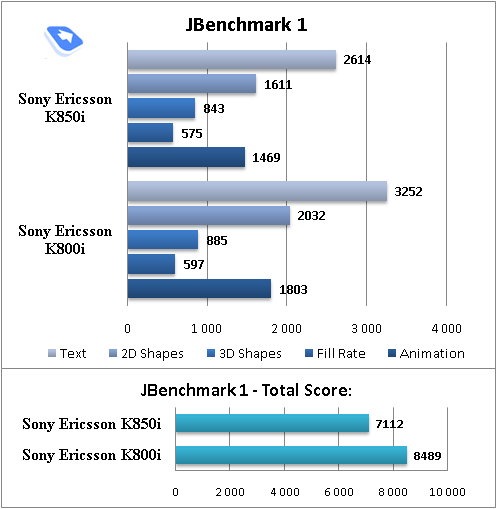
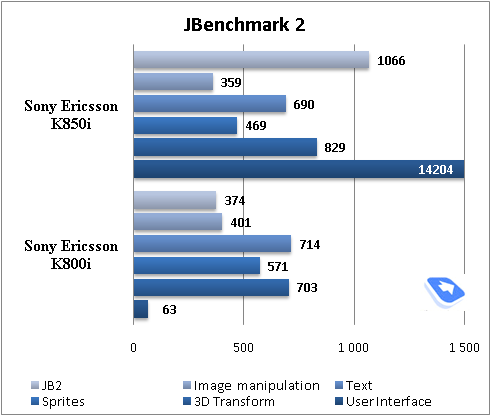
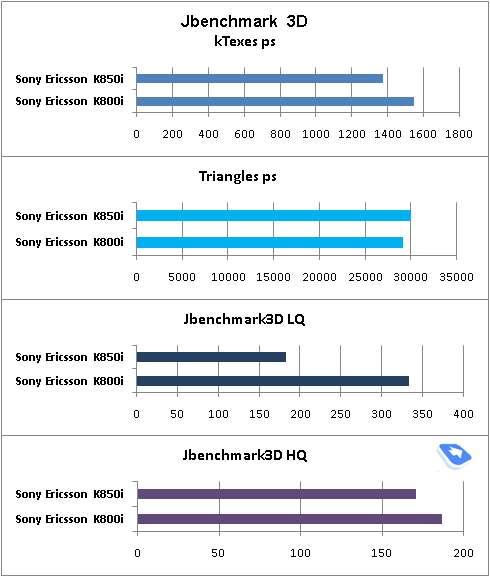
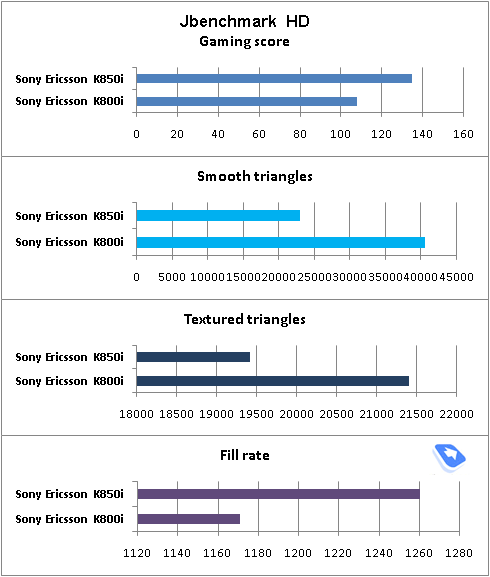
Back to the table of contents >>>
Connectivity
USB
On USB-connection you are forced to pick connection type – specifically whether you will be accessing data stored on the memory card or just keep managing the phone or activate Print mode. For the first mode we mentioned above the handset goes off and you gain access to the contents of both the memory card and the phone internal memory. Despite the maker claiming it to be USB 2.0, data transfer speed doesn’t exceed 500 Kb/s. If you just want your S500i to turn into a modem, then pick the second option, when you will have a chance to play around with various USB settings for going online.
Now there is a mode, where you can access the network set up on your PC from the phone, which does come in handy, for example when using ActiveSync.
Another supported protocol is MTP, which allows you to transfer music onto the device directly from Windows Media Player 10 or 11, which is quite suitable for those not willing to use Sony Ericsson’s own utility.
Bluetooth
The handset comes with EDR-enabled Bluetooth 2.0, the menu enables you to turn on enhanced power saving mode. There is also A2DP support, which allows employing wireless headsets with the K850i. Unlike the K800i and other previous models, Bluetooth can now be engaged while in Flight Mode. The handset supports the following profiles:
- A2DP
- Basic Imaging Profile
- Basic Printing Profile
- Dial-Up Networking Profile
- File Transfer Profile
- Generic Access Profile
- Generic Object Exchange Profile
- Handsfree Profile
- Headset Profile
- HID
- JSR-82 Java API
- Object Push Profile
- Personal Area Network Profile
- Serial Port Profile
- Service Discovery Application Profile
- Synchronization Profile
- SyncML OBEX binding
- Phonebook Access Proflle.
GPRS/EDGE/3G/HSDPA
It is one of the company’s first devices to support all connectivity options available, which makes it very versatile. The only thing left to note that absence of Infrared in the K850i is due to the fact that this standard is slowly dying, while the future will bring wireless data transfer protocols, like Wireless USB, which is currently on the “to-bundle” list.
Back to the table of contents >>>
Hardware platform A2, software platform A200
Many are curious what the difference between the A2 and its predecessor is, and how crucial the changes are. The hardware department hasn’t gone through too many improvements – while the RAM volume has been increased, the CPU utilized in the K850i is still ARM11 running at 220 MHz, which proves to be sufficient for most users, meaning that boosting the frequency would have led to an unreasonably power-hungry device. But speaking of really important performance-related facets, we can’t overlook somewhat sluggish image pop-up time in the Media section (thumbnails) due to the size of snaps. It normally takes a few seconds, but it is more likely to be about the throughput between the memory card and other components of the system. Personally, I see this as the main and the only reason. After loading the gallery, navigation goes just fine. In my opinion, ready thumbnails would have done much better, compared to dynamic rendering that takes place every time you enter the gallery. This trick is employed in a number of devices, naturally it has own downsides, but honestly, there are more positives to it.
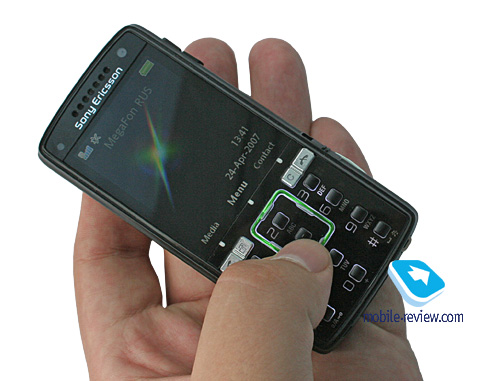
Software platform A200
The new generation of handsets boils down to another software department alone. The core of the update is JP-8 Java platform, which stands higher on the platform ladder than the previously embedded JP-7, so it brings along loads of new API, which are of great interest. Therefore let’s focus on this enhancement first and then move on to all other interface-related upgrades.
JP-8
The introduction of Java-platforms in Sony Ericsson was a consistent step on the way of getting application development for current generation of handsets easier. As a matter of fact, standardization always does a lot of good to third-party developers, saving them both time and money. First, like in Nokia’s and Motorola’s (a bit later) handsets, the JSR-248 or Mobile Service Architecture is supported. This umbrella standard defines the essential, minimal set of API for all today’s Java-armed handsets. Previously different Java editions utilized in phones provoked confusion among developers; however the industry has put it all together so as to avoid similar issues in future.
MSA includes a selection of obligatory standards, while a number of them are optional, meaning that the makers can either use them or not, which ensures a wide variety of feature packs. An example of an optional API for Sony Ericsson would be the JSR 256, which is Mobile Sensor API. With its help developers can make up applications embracing the abilities of the inbuilt motion sensor. Particularly in the K850i it is a stock game, where you can push a ball around. Other manufacturers can take this API on board as well – it is all up to them.
Let’s look into other API:
JSR 239 Java binding for OpenGL ES API – 3D graphics support;
JSR 177 Security and Trust Services API – support for user identification. The main API for mobile commerce in future;;
JSR229 Payment API – payments from a mobile terminal;
JSR 234 Advanced Multimedia – 3D sound, access to camera, bundled FM-tuner and RDS data, partly supported in the JP-7;
JSR 179 – Location API – application for handling coordinates, like those provided by Google Maps;
JSR 238 Internationalization – localization of devices and applications;
JSR 211 support for SIP – VoIP calls;
Looking at the list of API can reaffirm the fact that a feature phone of today is not too far away from smartphones, and eventually Java is getting to be not less interesting when it comes to expanding default functionality of mobile terminals and in the near term might actually enable the same functionality as Symbian-powered applications.
I shall make a reservation, though, that the K850i is one of the first handsets to support the JP-8 (two others - Z750i, W910i). And naturally, it would be at least unwise to expect Sony Ericsson to implement all the features the JP-8 brings about in this single phone. For example, VoIP-calls, for the most part, require a bundled WiFi module (not a must, but highly recommended, otherwise there is no point in VoIP). And in real life, carriers stand against the chance for users to save some money with VoIP-calls, that’s why some carries have discarded this feature in the Nokia N95 (like we mentioned in our review)
So owners of feature phones will have nothing else to do but hope for third-party applications, since the makers will limit this department (on their own or by requests from carriers). Remember the Nokia 6136 with UMA support (WiFi only for VoIP calls via the carrier’s native network with corresponding tariffs).
We couldn’t be happier with third-party developers acquiring access to all the required tools, so we can hope for these applications to come in future. But by the moment they actually arrive, the Sony Ericsson K850i will have been all but exhausted, but other models embracing the JP-8 will put these applications to better use.
But in order not to delve into specifications of various API and how they will influence the phones to come even deeper, I shall only note that with the HGE-100, an external GPS-receiver and a Java-application, or connection to Google Maps, even the Sony Ericsson K850i can provide you with navigation capabilities. It is quite another matter, though, that the handset filling in the gap between this model and the next flagship will carry this ability by default. It is quite remarkable that the story with the Sony Ericsson K800 and the Sony Ericsson K810 repeats – let’s say it will be the Sony Ericsson K860i. And I do they it will come with a shutter – my beloved marketers, this is by no means a gentle hint.
Nokia User Interface
One of the strategic decisions for Sony Ericsson was support for Java classes for Nokia UI in 2004. As a result of this field’s development the Sony Ericsson K850i, as well as other handsets running the JP-8 have switched over to the S40 philosophy. What is this all about?
First of all, the keypad layout. Before this moment, all handsets by Sony Ericsson had two soft-keys and a separate Back button that allows jumping back to the previous menu or standby. The new models have no trace of this key left. Now there are three soft-keys placed right beneath the display, whose actions bear strong resemblance of the S40 utilized by Nokia. Obviously, this move by Sony Ericsson along with standardization of Java (MSA support), makes the life of software developers so much easier. But is it any good for users? To my mind, again we run into the situation when previous user experience has no effect. All the things the company has been making us learn over the past 5 years in now gone, the new experience is here to stay. And it is interesting only for those who would like to migrate from Nokia- to Sony Ericsson-branded solutions, rather than the brand loyal users. It might be questionable, but after all it is a forced step – the only thing left to add is that the users will get used to the new layout sooner or later; thankfully it is not that hard.
Thereupon, I should also mention those considerable efforts made by Sony Ericsson to unify various device types. This way, even for UIQ 3.1 they employ a three-softkey setup, which lets a range of identical products to emerge within the company’s portfolio.

A complete list of changes in the interface brought about by the new setup can be found here >>>
In the next part we are going to talk on how Sony Ericsson wants to let all K850i buyers earn some coins, SVG implementation and its conditional character, new goodies in messages, which I loved, and also the rest of the handset’s abilities. Including some modes materialized in a really interesting way, specifically slide-show, media and many others.
Related links:
Eldar Murtazin (eldar@mobile-review.com)
Translated by Oleg Kononosov (oleg.kononosov@mobile-review.com)
Published — 19 July 2007
Have something to add?! Write us... eldar@mobile-review.com
|
News:
[ 31-07 16:21 ]Sir Jony Ive: Apple Isn't In It For The Money
[ 31-07 13:34 ]Video: Nokia Designer Interviews
[ 31-07 13:10 ]RIM To Layoff 3,000 More Employees
[ 30-07 20:59 ]Video: iPhone 5 Housing Shown Off
[ 30-07 19:12 ]Android Fortunes Decline In U.S.
[ 25-07 16:18 ]Why Apple Is Suing Samsung?
[ 25-07 15:53 ]A Few Choice Quotes About Apple ... By Samsung
[ 23-07 20:25 ]Russian iOS Hacker Calls It A Day
[ 23-07 17:40 ]Video: It's Still Not Out, But Galaxy Note 10.1 Gets An Ad
[ 19-07 19:10 ]Another Loss For Nokia: $1 Billion Down In Q2
[ 19-07 17:22 ]British Judge Orders Apple To Run Ads Saying Samsung Did Not Copy Them
[ 19-07 16:57 ]iPhone 5 To Feature Nano-SIM Cards
[ 18-07 14:20 ]What The iPad Could Have Looked Like ...
[ 18-07 13:25 ]App Store Hack Is Still Going Strong Despite Apple's Best Efforts
[ 13-07 12:34 ]Infographic: The (Hypothetical) Sale Of RIM
[ 13-07 11:10 ]Video: iPhone Hacker Makes In-App Purchases Free
[ 12-07 19:50 ]iPhone 5 Images Leak Again
[ 12-07 17:51 ]Android Takes 50%+ Of U.S. And Europe
[ 11-07 16:02 ]Apple Involved In 60% Of Patent Suits
[ 11-07 13:14 ]Video: Kindle Fire Gets A Jelly Bean
Subscribe
|
